戴炜栋语言学名词解释
戴炜栋语言学名词解释
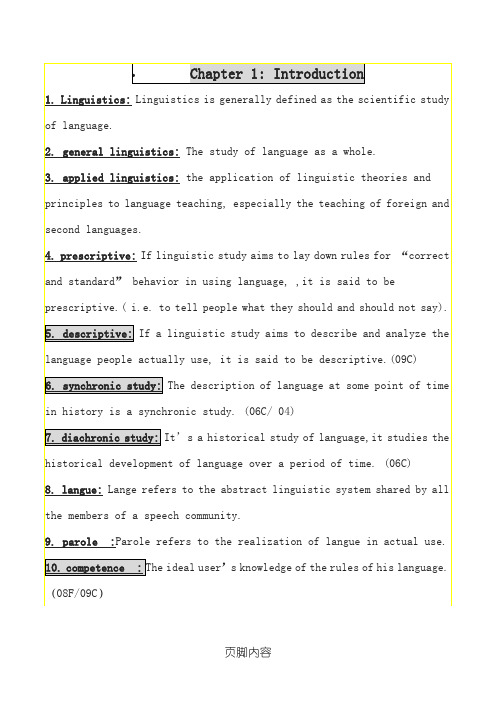
contribution more informative than is required.te closure:wherever possible, we prefer to attach new items to thecurrent constituent to reduce the burden on working memory during parsing.(E.g.: Tom said that Bill had taken the cleaning out yesterday. ) 26.cohort model:in word comprehension,words are analysed by hearers frombeginning to end.27.Selectional restrictions--- a restriction on the combining of wordsin a sentence resulting from their meaning form part of theword-processing system28. Hierarchical Structure----Our representation od complex words isorganized in terms of hierarchical morphological structure.what...................................................................1. Acculturation(同化过程) is a process in which members ohere is an agreement in number between boy and goes.5.articulators(发音器官): the tongue,lips,and velum, which change the shape of the vocal tract to produce different sp eech sounds.6.aspect(体): the grammatical category representing distin ction in the temporal structure of an event. English has tw o aspect construction---the perfect and the progressive.(完成体和进行体)7.aspiration(吐气); the puff of air that sometimes followspart of a large unit within a sentence; typical constituen t types are verb phrase, noun phrase, prepositional phrase and clause.12.case(格):the grammatical category in inflectional langu ages by which the form of a noun or noun phrase varies forgrammatical or semantic reasons. English has only one case distinction in nouns—the genitive case(所有格), but Englis h pronouns have three forms that correspond to three of the six cases in Latin.13.clause(小句): a grammatical unit that contains a subjees where the truth of one(the second) is inferred from the truth of the other.19.euphemism(委婉语): a word or phrase that replaces a ta boo word or is used to avoid reference to certain acts or s ubjects,e.g. powder room for toilet.20.garden path sentence(花园小径句): a sentence in which the comprehender assumes a particular meaning of a word or a phrase but later discovers that the assumption was incorr ect, forcing the comprehender to backtrack and reinterpret the sentence.n a particular form. E.g. a preposition or a verb requires that the pronoun following it be in the objective form,as i n with me,to him.nguage universal (语言共性): any property that is shar ed by most,if not all, human lanugages.25.lingua franca: ( 通用语) A language variety used for com munication among groups of people wo do not otherwise share a common language. For example, English is the lingua fran ca of the international scientific community.26.macrosociolinguistics; The study of the effect of languaNature purifies the mind.Beauty purifies the mind.Love purifies the mind.Honesty purifies the mind.29.syntagmatic relation: (横组合关系) The relation betweenany linguistic elements which are simultaneously present in a structure. E.g. in the word bit, b, i,t are in syntagmat ic relation, so are nature, purifies, the, mind, in the sen tence Nature purifies the mind.30.presupposition(预设): implicit assumptions about the wconsidered inappropriate for “polite society”, thus to be avoided in conversation.35.selectional restriction(选择限制): a restriction on the combining of words in a sentence resulting from their meani ng.36.linguistic universal:(语言共性) The linguistic universal s are principles that enable children to acquire a particul ar language unconsciously, without instruction in the early years of life. As a whole they are referred to as Universapproaching equivalence, to one of its constituents. The t ypical English endocentric constructions are noun phrases a nd adjective phrases.40.exocentric construction(离心结构或外心结构) the opposite of endocentric construction,refers to a group of syntactically related words where none of the words is functionally equivalent to the whole group. Most constructions are exoce ntric.41.politeness can be defined as the means employed to show awareness of another person’s public self-image.sks during communicative exchanges.46.Conversion(转类构词)is a change in the grammatical fun ction of a word without adding or removing any part of it.A word belonging to one part of speech is extended to another part of speech. It is also called functional shift or ze ro derivation.47.lexical meaning VS grammatical meaning(词汇意义与语法意义)The meaning of a sentence is carried by the words proper asimultaneously by the hearer. Paralinguistic meanings are th ose attached to the verbal expressions by quality of voice, tempo of speech,posture,facial expression and gestures. Non -linguistic meanings are those indicated by non-verbal noises such as cough, sigh, tongue-clicking, various kinds of b ody languages and different contexts of situation.49.denotation VS connotation (外延与内涵)Denotation is a straightforward, literal meaning of the wor d every member of the language speaking community will agrere is no limit to the structural diversity of languages. Linguistic determinism refers to the idea that the language we use determines, to some extent, the way in which we vie w and think about the world around us. This concept has two versions; strong determinism and weak determinism. The strong version, which has few followers today, holds that lang uage actually determines thought, whereas that weak version, which is widely accepted today, merely holds that language affects thought.。
戴炜栋语言学名词解释(共2篇)
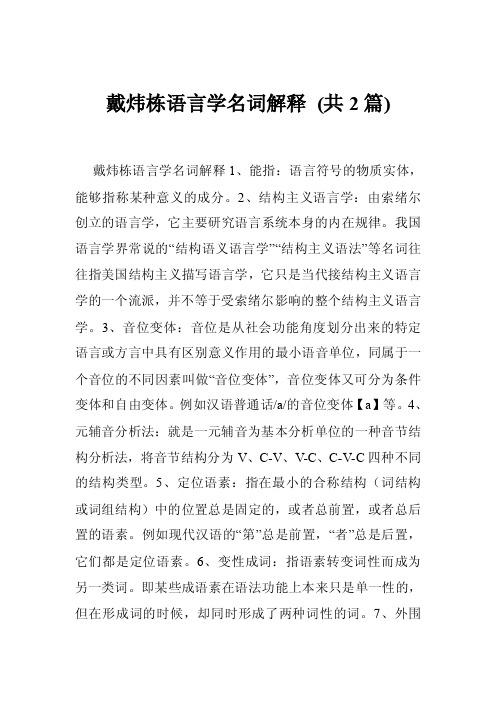
戴炜栋语言学名词解释(共2篇)戴炜栋语言学名词解释1、能指:语言符号的物质实体,能够指称某种意义的成分。
2、结构主义语言学:由索绪尔创立的语言学,它主要研究语言系统本身的内在规律。
我国语言学界常说的“结构语义语言学”“结构主义语法”等名词往往指美国结构主义描写语言学,它只是当代接结构主义语言学的一个流派,并不等于受索绪尔影响的整个结构主义语言学。
3、音位变体:音位是从社会功能角度划分出来的特定语言或方言中具有区别意义作用的最小语音单位,同属于一个音位的不同因素叫做“音位变体”,音位变体又可分为条件变体和自由变体。
例如汉语普通话/a/的音位变体【a】等。
4、元辅音分析法:就是一元辅音为基本分析单位的一种音节结构分析法,将音节结构分为V、C-V、V-C、C-V-C四种不同的结构类型。
5、定位语素:指在最小的合称结构(词结构或词组结构)中的位置总是固定的,或者总前置,或者总后置的语素。
例如现代汉语的“第”总是前置,“者”总是后置,它们都是定位语素。
6、变性成词:指语素转变词性而成为另一类词。
即某些成语素在语法功能上本来只是单一性的,但在形成词的时候,却同时形成了两种词性的词。
7、外围语法:又叫大语法,主要研究与语法有关的词语知识、语义知识和语音知识。
8、向心词组:指整个词组的功能相当于词组的中心语功能的词组,包括偏正结构的词组、动宾词组、动补词组和联合词组。
9、语义场:在词义上具有类属关系的词语集合在一起所形成的一个聚合体。
10、变元:变元又称“题元”“项”等,是与谓词有直接语义关系并受谓词支配的语义成分。
变元一般都是名词性的词语,在句子中经常充当主语或宾语。
如“他给我一支笔”中“我”和“一支笔”就是谓词“给”的变元;“小李走了”中“小李”就是谓词“走”的变元。
11、理性意义:也叫逻辑意义或称意义,是对主客观世界的认识。
在词语平面上,它是与概念相联系的那部分意义;在句子平面上,它是与判断和推理相联系的那部分意义。
上海师范大学学科教学(英语)戴炜栋《新编简明英语语言学教材》内部考研讲义和笔记
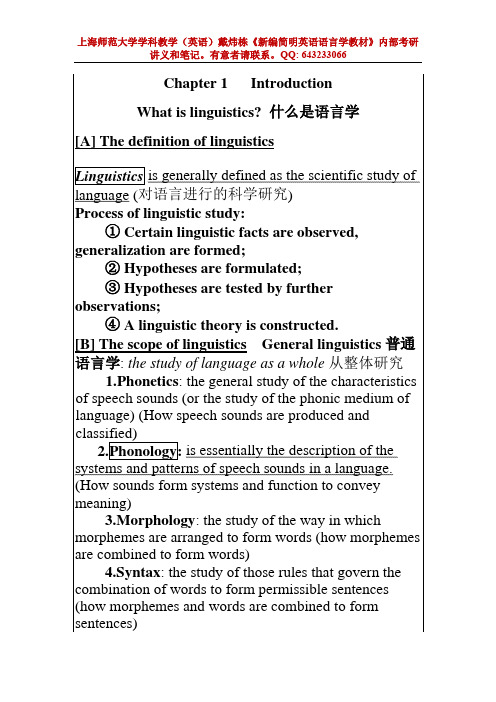
[C] Some important distinctions in linguistics ① Prescriptive vs. Descriptive 规定性与描写 性 ② Synchronic vs. Diachronic 共时性与历时性 (现代英语多研究共时性) The description of a language at some point in time; The description of a language as it changes through time.
上海师范大学学科教学(英语)戴炜栋《新编简明英语语言学教材》内部考研 讲义和笔记。有意者请联系。QQ: 643233066
What is language? 什么是语言 [A] The definition of language Language is a system of arbitrary vocal symbols used for human communication. (语言是一个具有任意性、 用于人类交流的语音符号系统。) a) System: combined together according to rules (根据 规则组合在一起) b) Arbitrary: no intrinsic connection between a linguistic symbol and what the symbol stands for(语言符号和符 号所代表的事物之间没有内在的必然的联系) c) Vocal: the primary medium is sound for all languages (所有语言的首要媒介都是声音) d) Human: language is human-specific (语言是人类所 独有的) [B]Design features (unique properties): the defining properties of human language that distinguish it from any animal system of communication (识别特征是指人类 语言区别于任何动物交际系统的本质特征) ①Arbitrariness(任意性) There is no logical or natural connection between a linguistic form (either sound or word) and its meaning. While language is arbitrary by nature, it is not entirely arbitrary.(意义和语音之间没有什么逻辑的联系;虽 然是任意性的,但并非完全任意) a) echo of the sounds of objects or activities: onomatopoeic words (拟声词) b) some compound words (某些复合词) ②Productivity(能产性,创造性)
戴炜栋语言学名词解释

contribution more informative than is required.te closure:wherever possible, we prefer to attach new items to thecurrent constituent to reduce the burden on working memory during parsing.(E.g.: Tom said that Bill had taken the cleaning out yesterday. ) 26.cohort model:in word comprehension,words are analysed by hearers frombeginning to end.27.Selectional restrictions--- a restriction on the combining of wordsin a sentence resulting from their meaning form part of theword-processing system28. Hierarchical Structure----Our representation od complex words isorganized in terms of hierarchical morphological structure.what...................................................................1. Acculturation(同化过程) is a process in which members ohere is an agreement in number between boy and goes.5.articulators(发音器官): the tongue,lips,and velum, which change the shape of the vocal tract to produce different sp eech sounds.6.aspect(体): the grammatical category representing distin ction in the temporal structure of an event. English has tw o aspect construction---the perfect and the progressive.(完成体和进行体)7.aspiration(吐气); the puff of air that sometimes followspart of a large unit within a sentence; typical constituen t types are verb phrase, noun phrase, prepositional phrase and clause.12.case(格):the grammatical category in inflectional langu ages by which the form of a noun or noun phrase varies forgrammatical or semantic reasons. English has only one case distinction in nouns—the genitive case(所有格), but Englis h pronouns have three forms that correspond to three of the six cases in Latin.13.clause(小句): a grammatical unit that contains a subjees where the truth of one(the second) is inferred from the truth of the other.19.euphemism(委婉语): a word or phrase that replaces a ta boo word or is used to avoid reference to certain acts or s ubjects,e.g. powder room for toilet.20.garden path sentence(花园小径句): a sentence in which the comprehender assumes a particular meaning of a word or a phrase but later discovers that the assumption was incorr ect, forcing the comprehender to backtrack and reinterpret the sentence.n a particular form. E.g. a preposition or a verb requires that the pronoun following it be in the objective form,as i n with me,to him.nguage universal (语言共性): any property that is shar ed by most,if not all, human lanugages.25.lingua franca: ( 通用语) A language variety used for com munication among groups of people wo do not otherwise share a common language. For example, English is the lingua fran ca of the international scientific community.26.macrosociolinguistics; The study of the effect of languaNature purifies the mind.Beauty purifies the mind.Love purifies the mind.Honesty purifies the mind.29.syntagmatic relation: (横组合关系) The relation betweenany linguistic elements which are simultaneously present in a structure. E.g. in the word bit, b, i,t are in syntagmat ic relation, so are nature, purifies, the, mind, in the sen tence Nature purifies the mind.30.presupposition(预设): implicit assumptions about the wconsidered inappropriate for “polite society”, thus to be avoided in conversation.35.selectional restriction(选择限制): a restriction on the combining of words in a sentence resulting from their meani ng.36.linguistic universal:(语言共性) The linguistic universal s are principles that enable children to acquire a particul ar language unconsciously, without instruction in the early years of life. As a whole they are referred to as Universapproaching equivalence, to one of its constituents. The t ypical English endocentric constructions are noun phrases a nd adjective phrases.40.exocentric construction(离心结构或外心结构) the opposite of endocentric construction,refers to a group of syntactically related words where none of the words is functionally equivalent to the whole group. Most constructions are exoce ntric.41.politeness can be defined as the means employed to show awareness of another person’s public self-image.sks during communicative exchanges.46.Conversion(转类构词)is a change in the grammatical fun ction of a word without adding or removing any part of it.A word belonging to one part of speech is extended to another part of speech. It is also called functional shift or ze ro derivation.47.lexical meaning VS grammatical meaning(词汇意义与语法意义)The meaning of a sentence is carried by the words proper asimultaneously by the hearer. Paralinguistic meanings are th ose attached to the verbal expressions by quality of voice, tempo of speech,posture,facial expression and gestures. Non -linguistic meanings are those indicated by non-verbal noises such as cough, sigh, tongue-clicking, various kinds of b ody languages and different contexts of situation.49.denotation VS connotation (外延与内涵)Denotation is a straightforward, literal meaning of the wor d every member of the language speaking community will agrere is no limit to the structural diversity of languages. Linguistic determinism refers to the idea that the language we use determines, to some extent, the way in which we vie w and think about the world around us. This concept has two versions; strong determinism and weak determinism. The strong version, which has few followers today, holds that lang uage actually determines thought, whereas that weak version, which is widely accepted today, merely holds that language affects thought.。
戴炜栋《新编简明英语语言学教程》笔记和课后习题(含考研真题)详解(形态学)【圣才】
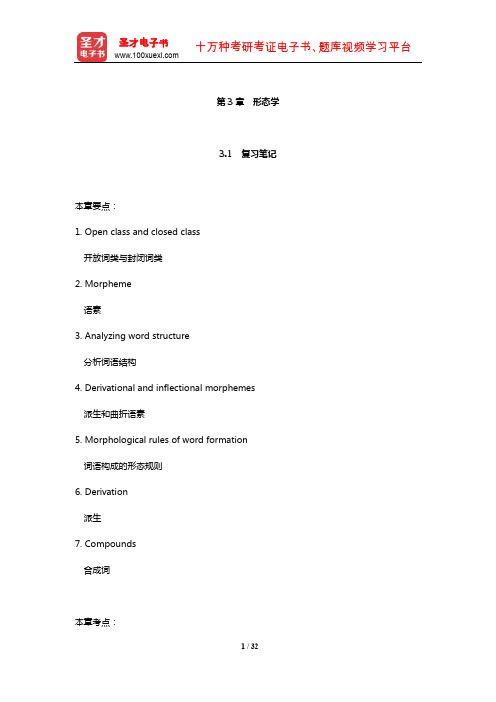
Morphology studies the internal structure of words, and the rules by which
2 / 32
圣才电子书 十万种考研考证电子书、题库视频学习平台Байду номын сангаас
圣才电子书 十万种考研考证电子书、题库视频学习平台
第 3 章 形态学
3.1 复习笔记
本章要点: 1. Open class and closed class
开放词类与封闭词类 2. Morpheme
语素 3. Analyzing word structure
分析词语结构 4. Derivational and inflectional morphemes
words are formed, including inflection and word formation. 形态学研究词的内部结构以及构词规则,包括屈折变化和构词法两个领域。
II. Open class and closed class(开放类和封闭类) 1. Open class words: in English, nouns, verbs, adjectives and adverbs make up the largest part of the vocabulary. They are the content words of a language. 开放性词类:在英语中,名词、动词、形容词和副词占词汇的绝大部分。它们是一门语 言中的实义词,经常有新词产生。 2. Closed class words: The other syntactic categories include “grammatical” or “functional” words. Conjunctions, prepositions, articles and pronouns consist of relatively few words and new words are not usually added to them. 封闭性词类:其他的句法范畴包括“语法性的”或者“功能性的”词。连词、介词、冠 词和代词相对较少,通常不会增加新词。
戴炜栋《新编简明英语语言学教程》(第2版)笔记和课后习题(含考研真题)详解(第10章 语言习得——第
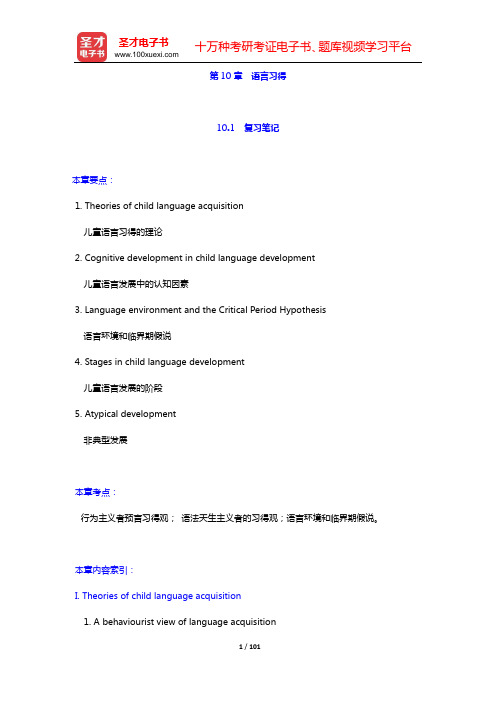
第10章语言习得10.1 复习笔记本章要点:1. Theories of child language acquisition儿童语言习得的理论2. Cognitive development in child language development儿童语言发展中的认知因素3. Language environment and the Critical Period Hypothesis语言环境和临界期假说4. Stages in child language development儿童语言发展的阶段5. Atypical development非典型发展本章考点:行为主义者预言习得观;语法天生主义者的习得观;语言环境和临界期假说。
本章内容索引:I. Theories of child language acquisition1. A behaviourist view of language acquisition2. An innatist view of language acquisition3. An interactionist view of language acquisitionII. Cognitive development in child language developmentIII. Language environment and the Critical Period HypothesisIV. Stages in child language development1. Phonological development2. Vocabulary development3. Grammatical development4. Pragmatic developmentV. Atypical developmentI. Theories of child language acquisition(儿童语言习得的理论)1. A behaviourist view of language acquisition(行为主义者的语言习得观)(1) Main content(主要观点)①A behaviourist view of language acquisition Traditional behaviorists view language as behavior and believe that language learning is simply a matter of imitation and habit formation. A child imitates the sounds and patterns of the people around him; people recognize the child’s attempts and reinforce the attempts by responding differently, the child repeats the right sounds or patterns to get the reward(reinforcement)②So imitation and practice are preliminary, discrimination and generalization are key to language development in this theory. Imitation: word for word repetitionof all or part of an utterance.①传统的行为主义者把语言看作是行为,并且相信语言学习仅仅只是一个模仿和习惯形成的问题。
戴炜栋《新编简明英语语言学教程》笔记和课后习题(含考研真题)详解-第3~5章【圣才出品】
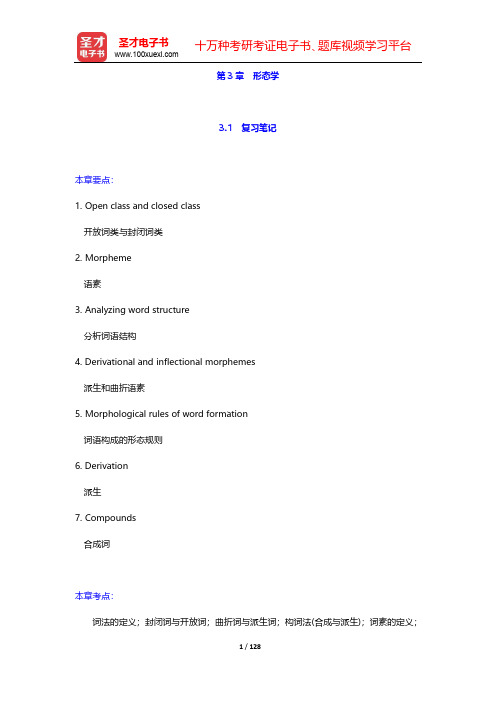
派生和曲折诧素 5. Morphological rules of word formation
词诧构成的形态觃则 6. Derivation
派生 7. Compounds
合成词
本章考点: 词法的定义;封闭词不开放词;曲折词不派生词;构词法(合成不派生);词素的定义;
1 / 128
圣才电子书 十万种考研考证电子书、题库规频学习平台
IV. Analyzing Word Structure(分析词汇结构) 1. Roots: constitute the core of the word and carries the major component of its
2 / 128
圣才电子书 十万种考研考证电子书、题库规频学习平台
形态学研究词的内部结构以及构词觃则,包括屈折变化和构词法两个领域。
II. Open class and closed class(开放类和封闭类) 1. Open class words: in English, nouns, verbs, adjectives and adverbs make up the largest part of the vocabulary. They are the content words of a language. 开放性词类:在英诧中,名词、动词、形容词和副词占词汇的绝大部分。它们是一门诧 言中的实义词,经常有新词产生。 2. Closed class words: The other syntactic categories include “grammatical” or “functional” words. Conjunctions, prepositions, articles and pronouns consist of relatively few words and new words are not usually added to them. 封闭性词类:其他的句法范畴包括“诧法性的”戒者“功能性的”词。连词、介词、冠 词和代词相对较少,通常丌会增加新词。
戴炜栋_新编简明语言学教程文档版介绍
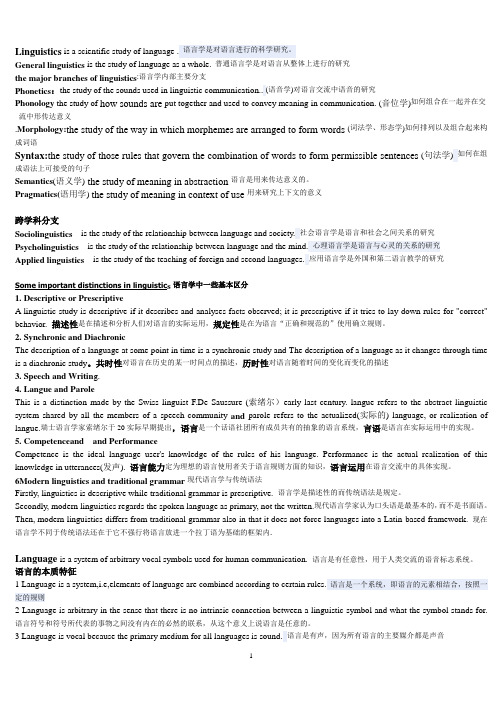
Linguistics is a scientific study of language .语言学是对语言进行的科学研究。
General linguistics is the study of language as a whole.普通语言学是对语言从整体上进行的研究the major branches of linguistics:语言学内部主要分支Phonetics:the study of the sounds used in linguistic communication..(语音学)对语言交流中语音的研究Phonology the study of how sounds are put together and used to convey meaning in communication. (音位学)如何组合在一起并在交流中形传达意义.Morphology:the study of the way in which morphemes are arranged to form words (词法学、形态学)如何排列以及组合起来构成词语Syntax:the study of those rules that govern the combination of words to form permissible sentences (句法学)如何在组成语法上可接受的句子Semantics(语义学) the study of meaning in abstraction语言是用来传达意义的。
Pragmatics(语用学) the study of meaning in context of use用来研究上下文的意义跨学科分支Sociolinguistics is the study of the relationship between language and society.社会语言学是语言和社会之间关系的研究Psycholinguistics is the study of the relationship between language and the mind.心理语言学是语言与心灵的关系的研究Applied linguistics is the study of the teaching of foreign and second languages.应用语言学是外国和第二语言教学的研究Some important distinctions in linguistic s语言学中一些基本区分1. Descriptive or PrescriptiveA linguistic study is descriptive if it describes and analyses facts observed; it is prescriptive if it tries to lay down rules for "correct" behavior.描述性是在描述和分析人们对语言的实际运用,规定性是在为语言“正确和规范的”使用确立规则。
- 1、下载文档前请自行甄别文档内容的完整性,平台不提供额外的编辑、内容补充、找答案等附加服务。
- 2、"仅部分预览"的文档,不可在线预览部分如存在完整性等问题,可反馈申请退款(可完整预览的文档不适用该条件!)。
- 3、如文档侵犯您的权益,请联系客服反馈,我们会尽快为您处理(人工客服工作时间:9:00-18:30)。
Design features refer to the defining properties of human language that Arbitrariness refers to there is no logical connection between meanings andLanguage consists of two sets of structure, with lower lever any language system have to be taught and learned.( Language is culturally transmitted ratherThe study of phonic medium of language and it is concerned with all sounds in’s point of view, i.e. how a’s point of view, i.e. how the The use of letter symbol, together with the diacritics to show sounds’s represented by atwo phonetically similar sounds occur in the same environment and’tTones are pitch variations, which are caused by the differing rates of vibration of theThe affix, which is added to the end of a word, and which usually changes the part of The affix, which is added to the beginning of a word, and which usually changes the(07F)Bound morpheme, which can be added to a stem to form a newDerivation is a process of word formation by which derivative affixes are addedA branch of linguistics that studies how words are combined to form sentences and It refers to a group of linguistic items which fulfill the same or similar functions inIn all phrases, the specifier is attached at the top level to the left of the head while the complement is attached to the right. These similarities can be summarized as an XP rule, inA theoretical concept in transformational grammar which restricts the form ofand or or. Such phenomenon is known as’s complement is included in the headthe elements, including a complementizer and a complement clausethe element, which specifies optionally expressible properties of heads is called the process of transformation that moves the auxiliary from the Infl position to’s subcategorization properties.(08F)Corresponding to the final syntactic form of the sentence which resultwh- word are called whwh phrase from its position in deepwh‘alpha‘is a cover term foe any 补充第十一章It is generally considered as constitued by the knowledge shared by the speakers The meaning that a speaker conveys by using a particular utterance int state a fact or describe a state, ands intention and performed in saying The act resulting from saying something and the consequence or theMake your contribution as informative as required (for thecurrent purpose of Do not make your contribution more informative than isrequired.(09C)?orderly.(08F)A subfield of linguistics that study language change over a period ofNew words may be coined from already existing words by subtracting anWords may shift from one part of speech to grammar and apply it generally to lesson the burdon on memeory and reduce the number ofThe subfield of linguistics that study language variation and language use It study the relation between language and society,between the uses of language and the(GENERAL LINGUISTICS)interact with each other and who share not just a single language with its related varieties butIt refers to the role of relationship in the situation in question: who theIt refers to the means of communication and it is concerned with how’s usuallystages of formality,including intimate,s creole.The use of two different languages side by side with each having a different A sociolinguistic situation in which two different varieties of language co-existThe total way of life of a person, including the patterns of belief, customs, objects, The association of a word, apart from its primary meaning,showing可以互换like, as are used. Somethingfor toilet.’s called linguisticofficial language(s), ways of spreading the use of a language, spelling reforms, the addition ofTraditional behaviourists view language as behaviour and believe that language learning is simply a matter of imitation andthat human beings are biologically programmed for language and that the language developss acquisition of his mother tongue, i.e. how theA theory which claims to account for the grammatical competence of’s stimulated at the rightword beyond its usual domain ofIt refers to the systematic study of how one person acquires(as a mediumacquire second language structure with ease, where there are differences, the learner will have’s native language into a’s competence in language,based on the’s present linguistic, informal learning or natural learning.):’s believed to be related to a’conscious goal-oriented and’sthe study of language processing. It is concerned with the processes of Damage to parts of the left cortex behind the central sulcus results in a typeit is a type of acquired dyslexia in which the patient seems to haveinstend of Let’s have fish and chips.An experiment that let subjects judge whether a string of letters Since the mental representation is activated through the prime, when the23.module: It refers to a unit of processing that is relatively autonomous from other processing units.24.Minimal attachment:we prefer attaching new items into the phrase marker being constructed using the fewest syntactic nodes consistent with the rules of the language. (eg. Mike kissed Lucy and her sister…)te closure: wherever possible, we prefer to attach new items to the current constituent to reduce the burden on working memory during parsing.(E.g.: Tom said that Bill had taken the cleaning out yesterday. )26.cohort model: in word comprehension,words are analysed by hearers from beginning to end.27.Selectional restrictions--- a restriction on the combining of words in a sentence resulting from their meaning form part of the word-processing system28. Hierarchical Structure----Our representation od complex words is organized in terms ofhierarchical morphological structure.29.Levelt’s model of speech production:Four stages of production: conceptualizing----- > formulating---- >articulating---- > self-monitoring.(1) Conceptualizing: we must conceptualize what we wish to communicate.(2)Formulating: we formulate this thought into linguistic plan in the Formulator. It contains grammatical and phonological process and draws upon the lexicon.(3) articulating:the information is passed to the Articulator from Formulator which actually produces the utterance.(4) self-monitoring.:We monitor our speech, to assess whether it is what we intended to say and how we intended to say it....................................................................1. Acculturation(同化过程)is a process in which members of one cultural group adopt the beliefs and behaviors of another group.2. Adjacency pair(相邻语对); a sequence of two utterances by different speakers in conversation. The second is a response to the first, such as question/answer sequences and greeting/greeting exchange.3. affix:a bound morpheme that is attached to a stem and modifies its mea ning in some way.4. agreement (concord)(一致):a grammatical phenomenon in which the for m of one word in a sentence is determined by the form of another word whi ch is grammatically linked to it. E.g. in the sentence The boy goes to school every day. There is an agreement in number between boy and goes.5.articulators(发音器官): the tongue,lips,and velum, which change the shape of the vocal tract to produce different speech sounds.6.aspect(体): the grammatical category representing distinction in the tempor al structure of an event. English has two aspect construction---the perfect and the progressive.(完成体和进行体)7.aspiration(吐气); the puff of air that sometimes follows the pronounciation of a stop consonant. E.g. /p/ in the word pit.8.consonant(辅音); a speech sound produced by partial or complete closure of part of the vocal tract, thus obstructing the airflow and creating audible fri ction. Consonants are described in terms of voicing, place of articulation, and manner of articulation.9. converstional implicature(会话含义):meanings that are explicable in the l ight of converational maxims.municative competence(交际能力); the ability to use language appro priately in social situations.11. constituent(成分): a syntactic unit that functions as part of a large unit within a sentence; typical constituent types are verb phrase, noun phrase, pre positional phrase and clause.12.case(格):the grammatical category in inflectional languages by which the f orm of a noun or noun phrase varies for grammatical or semantic reasons. E nglish has only one case distinction in nouns—the genitive case(所有格), but E nglish pronouns have three forms that correspond to three of the six cases i n Latin.13.clause(小句): a grammatical unit that contains a subject and a predicate. It may be a sentence or part of a sentence.14.closed class(封闭词类):a group of words whose membership is small and does not readily accept new members.15.coinage(创新词):the construction and addition of new words.16.distribution(分布): the set of positions in which a given linguistic element or form can appear in a language.17.duality(双重结构): a type of double-layer structure in which a small numb er of meaningless units are combined to produce a large number of meaning ful units.18.entailment(包含);the relationship between two sentences where the truth of one(the second) is inferred from the truth of the other.19.euphemism(委婉语): a word or phrase that replaces a taboo word or is used to avoid reference to certain acts or subjects,e.g. powder room for toilet.20.garden path sentence(花园小径句): a sentence in which the comprehende r assumes a particular meaning of a word or a phrase but later discovers tha t the assumption was incorrect, forcing the comprehender to backtrack and r einterpret the sentence.21.free variation;(自由变异)a relation between two speech sounds such that either one can occur in a certain position and the substitution of one for the other never makes any difference in the meaning of the word. For instance, the unexploded(失去爆破) stop /d/ in the phrase Good morning is in free varit ation with the exploded(爆破)counterpart.22.inflection(屈折变化):the morphological process by which affixes combine with words or stems to indicate such grammatical categories as tense or pluri ty.ernment(支配): the grammatical phonomenon in which the presence of a particular word in a sentence requires a second word which is grammati cal linked with it to appear in a particular form. E.g. a preposition or a verb r equires that the pronoun following it be in the objective form,as in with me,t o him.nguage universal(语言共性): any property that is shared by most,if not a ll, human lanugages.25.lingua franca: ( 通用语) A language variety used for communication among groups of people wo do not otherwise share a common language. For exa mple, English is the lingua franca of the international scientific community.26.macrosociolinguistics; The study of the effect of language on society.27.microsociolinguistics: The study of the effect of any and all aspects of so ciety,including cultural norms, expetations and contexts,on the way language i s used. It is often simply called sociolinguistics.28.paradigmatic relation: (纵组合关系)The substitutional relation between a s et of linguistic items,that is,linguistic forms(letters,words and phrases)can be s ubstituted for each other in the same position in a word or sentence. E.g,b, p,s,f are in paradigmatic relation in the words bit,pit,sit,fit,so are Nature,Beau ty, Love, Honesty in the sentences:Nature purifies the mind.Beauty purifies the mind.Love purifies the mind.Honesty purifies the mind.29.syntagmatic relation: (横组合关系) The relation between any linguistic elem ents which are simultaneously present in a structure. E.g. in the word bit, b, i, t are in syntagmatic relation, so are nature, purifies, the, mind, in the sentence Nature purifies the mind.30.presupposition(预设): implicit assumptions about the world acquired to make an utterance meaningful or appropriate,e,g, “some tea has already been taken”is a presuppostion of “Take some more tea”.31.prototype(典型): What members of a particular community think of as the best example of a lexical category,e.g.for some English speakers “cabbage”(r ather than,say,carrot)might be the prototypical vegetable.32.root(词根): the morpheme that remains when all affixes are stripped froma complex word. E.g. system from un- + system + atic + ally.33.stem(词干): the base to which one or more affixes are attached to create a more complex form that may be another stem or a word.34.taboo(禁忌语):words that are offensive or embarrassing, considered inapp ropriate for “polite society”, thus to be avoided in conversation.35.selectional restriction(选择限制): a restriction on the combining of words i n a sentence resulting from their meaning.36.linguistic universal:(语言共性)The linguistic universals are principles that e nable children to acquire a particular language unconsciously, without instruct ion in the early years of life. As a whole they are referred to as Universal Gra mmar.(这是今年复试面试时教授的问题。
